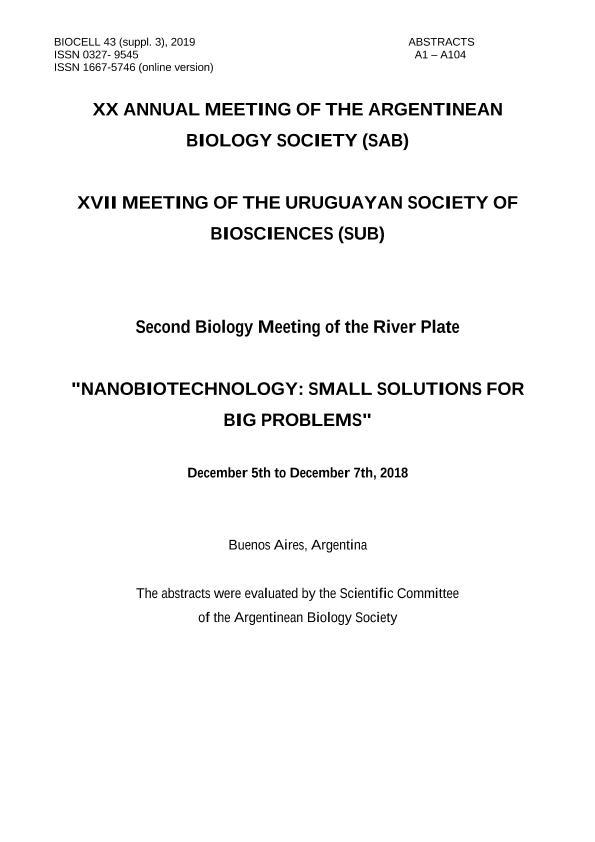Mostrar el registro sencillo del ítem
dc.contributor.author
Achimón, Fernanda

dc.contributor.author
Jacquat, Andrés Gustavo

dc.contributor.author
Brito, Vanessa Daniela

dc.contributor.author
Dambolena, José Sebastián

dc.contributor.author
Zygadlo, Julio Alberto

dc.contributor.author
Pizzolitto, Romina Paola

dc.date.available
2022-08-04T16:37:21Z
dc.date.issued
2019
dc.identifier.citation
Effects of carbon sources on secondary metabolites biosynthesis by Fusarium verticillioides; XX Annual Meeting of the Argentinean Biology Society and XVII Meeting of the Uruguayan Society of Biociences; Buenos Aires; Argentina; 2018; 1-2
dc.identifier.issn
0327-9545
dc.identifier.uri
http://hdl.handle.net/11336/164249
dc.description.abstract
Fusarium verticillioides is one of the most important fungal pathogens of maize, being responsible of major economic losses worldwide due to its effect on grain quality and mycotoxincontamination, particularly fumonisin B1 (FB1), which is extremely harmful to human and animal health. Secondary metabolites (SMs) production often occurs during stationary phase.F. verticillioides SMsinclude toxins such as FB1, volatile organic compounds such assesquiterpenes (SQT) and pigments (naphthoquinones), among other metabolites. The aim of the present study was to determine the effect of different carbon sources, consisting of glucose, sucrose, lactose, fructose or xylose, on vegetative growth and secondary metabolism in F. verticillioides. For evaluation of growth, F. verticillioides M3125 was incubated at 28°C in Czapek Dox Agar (CDA)supplemented with different carbon sources. For evaluation of secondary metabolites, liquid GYAM medium was used (adjusted to pH 3) andcultureswere incubatedwith shaking at 25°C for 7 days. At the end of the incubation period, pHvalue was registered, FB1 quantification was performed using a HPLC, SQT quantification was carried out using a GC-MS and total naphthoquinones were quantified with a spectrophotometer. Lower lag phase values were achieved with lactose and sucrose as carbon sources (both disaccharides), compared to glucose, xylose and fructose (monosaccharides). This may be explained by the development of more extended andpoor branched hyphae when the fungus grows with disaccharides as carbon sources. This may be a strategyto explore the surrounding media for areaswith simpler carbohydrates. The growth rate was higher with fructose and conidiation was higher with lactose. FB1 biosynthesis was statistically higher with sucrose and glucose (both with pH 3.5) and lower with xyloseand fructose. On the other hand, naphthoquinone biosynthesis was statistically higher with fructose (pH 3.7) followed by xylose (pH 4.8),while lower values were achieved with glucose and sucrose. Lactose did not support the biosynthesis of these SMs.On the other hand, SQT biosynthesis was statistically higher with xylose compared to the other carbon sources.According to our results, growing parameters, conidiation and biosynthesis of secondary metabolites are regulated by both environmental (pH) and nutritional factors (carbon source).Also, our results suggest an inverse relationship between FB1 and naphthoquinones biosynthesis. It is well documented that both metabolites proceed via the polyketide route by formation of a common precursor. In addition, there are global and specific regulators that respond to environmental signals and activate one of the metabolites while repressing the other. SQT productiondoes not show apattern with the other SMs studied. In fact, its biosynthesis proceeds through a different pathway, the mevalonic acid pathway. It has been proposed that trichodiene synthase activity is optimum at pH values near 6, which could explained the higher amount of SQT produced with xylose as carbon source (pH 4.8). However, xylose itself could represent a signal that inducesSQT biosynthesis.
dc.format
application/pdf
dc.language.iso
eng
dc.publisher
Tech Science Press

dc.rights
info:eu-repo/semantics/openAccess
dc.rights.uri
https://creativecommons.org/licenses/by-nc-sa/2.5/ar/
dc.subject
SECUNDARY METABOLITES
dc.subject
FUSARIUM VERTICILLIOIDES
dc.subject
CARBON SUORCES
dc.subject.classification
Otras Ciencias Biológicas

dc.subject.classification
Ciencias Biológicas

dc.subject.classification
CIENCIAS NATURALES Y EXACTAS

dc.title
Effects of carbon sources on secondary metabolites biosynthesis by Fusarium verticillioides
dc.type
info:eu-repo/semantics/publishedVersion
dc.type
info:eu-repo/semantics/conferenceObject
dc.type
info:ar-repo/semantics/documento de conferencia
dc.date.updated
2022-06-22T20:13:27Z
dc.journal.volume
43
dc.journal.number
Suplemento 3
dc.journal.pagination
1-2
dc.journal.pais
Argentina

dc.journal.ciudad
Mendoza
dc.description.fil
Fil: Achimón, Fernanda. Consejo Nacional de Investigaciones Científicas y Técnicas. Centro Científico Tecnológico Conicet - Córdoba. Instituto Multidisciplinario de Biología Vegetal. Universidad Nacional de Córdoba. Facultad de Ciencias Exactas Físicas y Naturales. Instituto Multidisciplinario de Biología Vegetal; Argentina
dc.description.fil
Fil: Jacquat, Andrés Gustavo. Consejo Nacional de Investigaciones Científicas y Técnicas. Centro Científico Tecnológico Conicet - Córdoba. Instituto Multidisciplinario de Biología Vegetal. Universidad Nacional de Córdoba. Facultad de Ciencias Exactas Físicas y Naturales. Instituto Multidisciplinario de Biología Vegetal; Argentina
dc.description.fil
Fil: Brito, Vanessa Daniela. Consejo Nacional de Investigaciones Científicas y Técnicas. Centro Científico Tecnológico Conicet - Córdoba. Instituto Multidisciplinario de Biología Vegetal. Universidad Nacional de Córdoba. Facultad de Ciencias Exactas Físicas y Naturales. Instituto Multidisciplinario de Biología Vegetal; Argentina
dc.description.fil
Fil: Dambolena, José Sebastián. Consejo Nacional de Investigaciones Científicas y Técnicas. Centro Científico Tecnológico Conicet - Córdoba. Instituto Multidisciplinario de Biología Vegetal. Universidad Nacional de Córdoba. Facultad de Ciencias Exactas Físicas y Naturales. Instituto Multidisciplinario de Biología Vegetal; Argentina
dc.description.fil
Fil: Zygadlo, Julio Alberto. Consejo Nacional de Investigaciones Científicas y Técnicas. Centro Científico Tecnológico Conicet - Córdoba. Instituto Multidisciplinario de Biología Vegetal. Universidad Nacional de Córdoba. Facultad de Ciencias Exactas Físicas y Naturales. Instituto Multidisciplinario de Biología Vegetal; Argentina
dc.description.fil
Fil: Pizzolitto, Romina Paola. Consejo Nacional de Investigaciones Científicas y Técnicas. Centro Científico Tecnológico Conicet - Córdoba. Instituto Multidisciplinario de Biología Vegetal. Universidad Nacional de Córdoba. Facultad de Ciencias Exactas Físicas y Naturales. Instituto Multidisciplinario de Biología Vegetal; Argentina
dc.relation.alternativeid
info:eu-repo/semantics/altIdentifier/url/https://www.biologia.org.ar/jornadas-anteriores/
dc.conicet.rol
Autor

dc.conicet.rol
Autor

dc.conicet.rol
Autor

dc.conicet.rol
Autor

dc.conicet.rol
Autor

dc.conicet.rol
Autor

dc.coverage
Nacional
dc.type.subtype
Reunión
dc.description.nombreEvento
XX Annual Meeting of the Argentinean Biology Society and XVII Meeting of the Uruguayan Society of Biociences
dc.date.evento
2018-12-05
dc.description.ciudadEvento
Buenos Aires
dc.description.paisEvento
Argentina

dc.type.publicacion
Journal
dc.description.institucionOrganizadora
Sociedad Argentina de Biología
dc.source.revista
Biocell

dc.date.eventoHasta
2018-12-07
dc.type
Reunión
Archivos asociados
